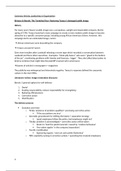Samenvatting
Summary Articles Leadership in Organizations 2019
Summary of the articles for the course Leadership in Organizations (2018/2019): -Alvesson, M., and Svenningsson, S. (2003). Managers doing leadership: the extra-ordinarization of the mundane. -Brinson, S.L. and W.L. Benoit. (1999). 'The Tarnished Star. Restoring Texaco's Damaged Public Image'. ...
[Meer zien]




